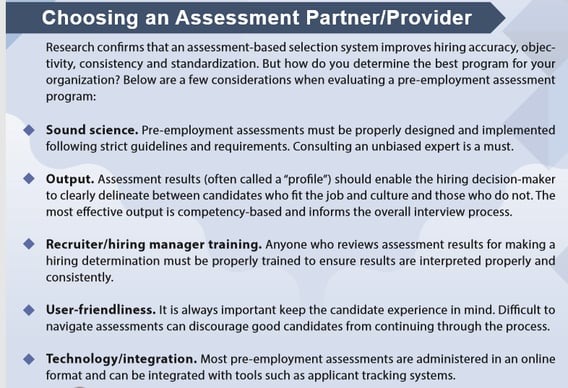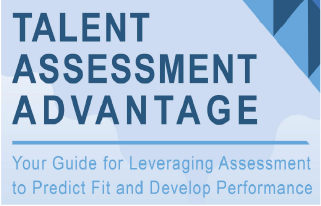Talent acquisition is both an art and a science. Hiring the wrong candidate is costly in terms of productivity, money, and morale.
There are four executive search best practices that, when followed, can help you make smarter hiring decisions and getting the right talent fit.
Follow the four talent management practices list below to help you better talent fit decisions.
Early in my career as a department leader and people manager, I learned a very valuable lesson. One of my employees was not meeting expectations, despite my multiple attempts to “change” him into the employee I needed. When I finally gave him the news that we were parting ways, his response was a quick: “What took you so long?” True story. Lesson learned.
The time it took me to make and implement the clear decision finally was wasted time. We were about significant growth, and this was an unnecessary distraction, not just to me but to my team. As a leader of people, we are only as effective as the lowest performer on our team.
A smart leader makes 1) the very best hiring decisions through sound science and discipline and 2) the tough people decisions based on observable and reliable data. And, the stakes get higher as these decisions take place at the top of the organization. We are not taking into account the ancillary frustration and distractions to the business, cost estimates for executive turnover range as high as 150 percent of the annual salary (Inc.com).
You may have a similar story. You may have someone at this very moment who fits the category of I know what I must do. The picture is clear. It’s time for me to make the tough call. If you are in this situation or can coach someone who is, a healthy perspective to take is that the difficult news rarely comes as a complete surprise to the impacted individual when performance issues are at the center. Either deep down or on the surface, he or she knows. Moreover, these types of talent decisions most often end up good for the leader and the organization, as well as suitable for the departing individual and the next opportunity he/she finds – I know that I came into new opportunities with fresh gusto!
To help you make right and timely talent decisions, this article includes ways you can ensure your hiring processes at all levels in the organization, but particularly at the high-stakes level of executive decision-making, are geared towards hiring the best-fit talent for your roles and culture following best practices.
We also outline key considerations for making the tough talent decisions in a way that is right for the individual, leader, and organization. We hope to equip you and your leaders with the right tools, criteria and prospective to hire and decide status right, resulting in an agile and supercharged workforce.
Best Practices in Hiring Right Talent
Best Practice #1 – Alignment with company mission, vision, values, and culture. The most effective talent management practices are aligned with the business, in every way, along the employee lifecycle (see Figure 1 below) – supporting the employment brand in hiring, developing leaders who fit the culture, and managing performance against key outcomes and metrics. By creating a competency framework, your talent management systems will also be well-integrated by speaking the same behavioral language. Alignment and integration create more powerful talent management by enabling you, for example, to hire the right type of employee or leader who not only meets the requirements of the role but who fits the culture – a combination shown to increase engagement, performance and retention.

Best Practice #2 – Study the jobs and your process for hiring. To establish a hiring process that is optimized for success, you need to go beyond a job description. As we do with many of our clients, going deeper to fully understand what success looks like, especially critical roles, in terms of knowledge, skills, abilities and behaviors, is worth the effort. This type of “job analysis” includes:
- Reviewing all available job descriptive literature
- Evaluating training and performance management documents
- Interviewing Subject Matter Experts (SMEs) to gain first-hand job insights
- Observing employees on the job
Once you have a clear and vibrant picture of the jobs, doing your due diligence in reviewing the steps and tools that are in place for hiring is another best practice. For example, a common exclusion in the hiring process is a Realistic Job Preview, which would include a representation of a “day in the life” on the job with what I like to call a description of the “good, bad and ugly.”
You want to make sure the candidate understands the full scope of the role in realistic terms to give him/her a chance to “self-select out,” enabling you to spend your time only with interested candidates.
For more information on other hiring best practices, please click on our ebook:
Best Practice #3 – Make smart strategic partner decisions. Who you put your trust in as your partner in any area of talent management is a critical decision. As an example, the talent assessment industry is a very crowded market and made more complicated by the introduction of recruitment technology. The choice is tough and critical. Here is a list of criteria you can use to make the best choice of an assessment partner possible:

Best Practice #4 – Focus on excellent execution and follow-up. Any time changes or updates are made to a hiring process and/or when any new hiring leader is brought on board; diligence should be done in training for consistent and appropriate use. This is especially true if you are introducing a new assessment process. Training should include proper use of the assessment for hiring and development applications, as well as refresher training on interviewing skills. One of the many benefits of assessments is that the data and insights help inform and instruct subsequent interviews. Another best practice when rolling out a new hiring process is gaining advocacy within the ranks. Ask for plenty of feedback to make sure you are well-aligned and to maximize adoption and compliance.
Considerations for Making Tough Talent Decisions
Consideration #1 – Calculate the impact. What is the cost to the organization while the decision is not being made? In my case, I can say without counting hours, days, or weeks that I was frequently distracted and frustrated by my employee situation. What started as my good intention to help this individual improve led to my credibility as a leader being potentially impacted by my lack of decisive action. The impact is observable by your team, which only increases the scope…see next Consideration.
Consideration #2 – Where does the responsibility lie? Leaders, especially executives, are hired to make tough, often unpopular decisions when the data points clearly in a particular direction. My two favorite football teams, the Oklahoma Sooners and Kansas City Chiefs, both have had tremendous offenses in recent years with defenses that have held them back due to stale and ineffective coaching by the Defensive Coordinators. The statistics were clear. They both needed to go, but the decision seemed delayed by loyalty. Now that the decisions have been made, both defenses have improved dramatically, and both teams have a chance at a championship. Football is a big corporation, and teams can be supercharged (as mine has been with the statistics to back up the claim) by making the right talent decisions.
Consideration #3 – Have you applied sound performance and talent management practices? Human Resources may be the ones to create talent tools and processes, but every great leader must implement them as designed. Have you adequately assessed the individual using the prescribed performance management process? Do you have a clear plan for succession as these types of decisions are made? These are critical questions when considering letting someone go. One study found that 87% of “best-in-class” companies surveyed used some form of assessment data when making succession planning decisions (Aberdeen Group). Your Human Resources team should always be consulted when facing these types of decisions.
Consideration #4 – Think of the individual. The worse feeling is to be “led on” in any relationship. Leaders need a deep reality and gut check if this is occurring. Avoiding and delaying a necessary tough decision is not showing respect for the individual. Put yourself in their shoes and do as Spike Lee has touted: Do The Right Thing.
Summary
I encourage you to apply best practices and take into account key considerations in your management of talent, but the best outcomes ultimately result from a leader doing what is right for all parties involved. Successful and thriving organizations have sound talent management practices but also leaders who put the company good above their agenda and insecurities to make the right decisions. My lessons learned made me a better manager and leader, but I continued to develop my talent management skills as my leadership responsibilities grew. In an executive capacity, I relied heavily on sound principles for hiring, developing and managing a team of passionate and aligned professionals. I never underestimated the importance of talent.
We hope the insights and information shared in this article will help you hire the right talent and make the necessary tough talent decisions. Through the power of great talent and talent management, you can set a direct course for supercharging your business.
About The Author

Scott McTague is the Senior Vice President of Talent Fit Solutions for CMP. Scott's expertise is in Talent Selection and Development, Assessment Science and Prediction, Recruitment and Search, and Leadership Development.
Please contact Scott McTague at scottm@careermp.com with questions and comments.





